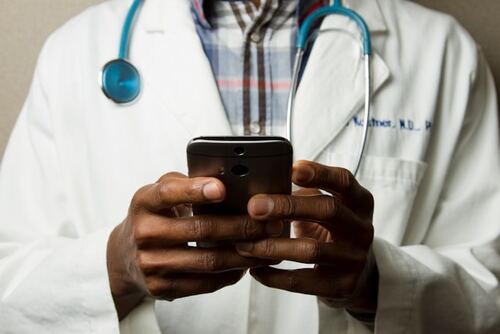The digital transformation in healthcare is altering the manufacturing and development capability and originality. Medical facilities use cutting-edge technology to increase employee efficiency, improve patient care, save expenses, reorganize workflows, and speed up diagnosis.
Healthcare organizations have adopted digital technologies unevenly during the past 20 years, concentrating on conventional approaches. COVID-19 prompted the shift towards home treatment and virtual healthcare. Driven by consumer trends, tech progress, talent shifts, and therapies, this digital transformation boosts efficiency and innovation.
We delve into the changing healthcare landscape and discuss the advantages of digital technologies, new trends, and the challenges of complete industry digitization.
What does Digital Transformation in Healthcare mean?
Digital transformation in healthcare enables modular digital solutions, revolutionizing patient care. Electronic health records, telemedicine, and AI-enabled medical devices streamline workflows, improve accessibility, and ease knowledgeable decision-making. These advancements authorize patients to interact with healthcare providers competently, transforming the healthcare landscape. Digitalization offers dynamic solutions, from novel medicines to seamless scheduling, marking a paradigm shift in healthcare accessibility, efficiency, and patient-provider interaction.
Digital health evolution began with Electronic Health Records (EHRs) and is now progressing to advanced applications like health wearables and mobile apps due to tech growth. Data analysis is improved by artificial intelligence and machine learning for accurate diagnosis and individualized treatments. Secure data-sharing platforms and interoperability initiatives enable seamless communication among healthcare professionals. This authorization grants patients control over their health info, revolutionizing healthcare by fostering collaboration, accessibility, and modified care.
Important of Digital Transformation in Healthcare
The authoritative digital transformation in healthcare is evident: 80% of healthcare managers believe mechanization and digital technologies enhance productivity meaningfully. Digitization automates tasks, freeing healthcare professionals from patient care and improving patient outcomes through streamlined access to records and tailored treatment plans. Moreover, it fuels novelty by integrating AI, data analytics, and IoT devices, foremost groundbreaking therapies. Frugally, it reduces errors and indorses preventive care, cutting costs meaningfully and ensuring excellent healthcare access altogether.
Advantages of Digital Transformation in Healthcare
Healthcare organizations can improve patient experience and outcomes by accepting digital tools and technologies, transforming care delivery for improved competence and effectiveness.
Improved Patient Care & Outcomes: Digital tools like secure messaging platforms and enduring portals enable unified communication between patients and healthcare breadwinners. These tools empower patients to schedule calls, inquire, receive test results, and admission educational capitals, enhancing their active participation in healthcare.
Enhanced Efficiency & Cost-Effectiveness: Automating healthcare procedures trims costs and promotes affordability. By plunging reliance on old-style services, automation enhances reserve allocation, improving the capability and accessibility of healthcare distribution.
Empowering Healthcare Professionals: Digital transformation empowers healthcare specialists using real-time data, progressive analytics, and telemedicine tools. Fee to comprehensive information improves decision-making, purifying patient care and over-all healthcare outcomes.
Patient Engagement & Experience: Healthcare specialists leverage extensive patient data, such as health profiles and medical histories, to craft personalized treatment plans. This tailored method ensures optimal care, refining outcomes, and patient gratification.
How Digital Transformation Fuels Healthcare Innovation?
There are numerous ways digital healthcare transformation is a heavy innovation in healthcare. Events are being streamlined, patient care is being healthier, and ground-breaking novelties are being made, totally altering the industry.
1. Artificial Intelligence & Machine Learning
AI is altering healthcare, helping doctors, patients, and work. AI achieves tasks rapidly and reasonably, from deciphering genetic codes to aiding operations and nursing chronic conditions. Compared to old-style methods, AI & ML offer remarkable precision and accuracy, yielding an understanding of treatment variations, patient outcomes, and diagnosis. A notable example of AI’s effectiveness is diagnostics, a field where human error can be deadly. In a study, an AI model outperformed 11 pathologists in breast cancer diagnosis, a critical area given its high mortality rate among women.
Additionally, AI is pivotal in the realm of Precision Medicine & Genomics. It analyzes massive genomic data, aiding in personalized actions tailored to an individual’s genetic greasepaint. By deciphering multifaceted genetic designs, AI contributes to understanding diseases at a molecular level, revolutionizing drug detection and treatment plans.
Moreover, AI augments screening mammography done by Computer-Assisted Detection (CAD) tools, meaningfully enhancing accuracy. Its addition with deep learning methods has markedly improved diagnostic precision, safeguarding earlier and more accurate discovery of diseases like breast cancer. AI, alongside Machine Learning, reshapes healthcare, providing more efficient, precise, and personalized medical interventions, heralding digital transformation in healthcare.
2. Patient Portals
Patient portals represent a pivotal advancement of digital transformation in the healthcare industry, offering online platforms enabling patients access. This innovation fosters convenience and transparency, a sentiment 82% of healthcare professionals echoed. Patient portals remove the need for manual record transfers and rationalization info sharing between patients and healthcare breadwinners.
Notably, these portals Simplify Appointment Scheduling and ensure Data Availability of patient data. Patients can effortlessly view their medical history, prescriptions, and visit notes. Moreover, these platforms facilitate direct messaging with doctors, enhancing patient-provider communication. Overall, patient portals enhance efficiency, accessibility, and communication in healthcare, marking a significant step toward a more integrated and patient-centric approach.
3. Wearable Devices
Traditionally, people remained doctors reactively, seeking help only when ill or throughout yearly checkups. Today, there’s a shift towards active health management, with individuals frequently using wearable devices to screen their well-being. This healthcare digital alteration tendency is driving a booming market, set to reach $74 billion by 2026, up from $27 billion in 2020. Wearables like exercise trackers, fitness bands, oximeters, and sweat meters (beneficial for diabetic patients) are gaining admiration.
These plans empower users to track their health and provide real-time data to medical professionals. This real-time data conversation is pivotal in Remote Patient Monitoring (RPM), where patients’ health data is monitored outside conventional clinical locations. Wearables production is crucial in RPM, allowing healthcare providers to measure patients’ health continuously. This shift towards proactive well-being monitoring, facilitated by clothing technology, marks a significant progression in healthcare.
4. Healthcare Internet of Things
Before the Internet of Things (IoT) era, patient-doctor interactions were limited to in-person calls and texts, hindering nonstop health monitoring. IoT-enabled devices have revolutionized healthcare by enabling distant patient monitoring. This technology ensures patient safety, enhances doctor-patient connections, and improves care. IoT facilitates real-time tracking of patients’ health through wearables and home monitoring tools, letting doctors make informed choices based on accurate data.
This proactive method leads to better treatment outcomes and reduced healthcare costs. Patients also benefit from personalized care through devices like suitability bands, which track vital signs. IoT devices provide announcements for health visits, monitor daily doings, and enhance care for older people through real-time remote monitoring, comforting medical professionals and families. IoT is transforming healthcare by refining patient engagement, doctor vigilance, and overall competence in healthcare delivery.
5. TeleHealth & Virtual Doctor Visits
The faster increase in virtual medical visits due to the COVID-19 pandemic has reshaped healthcare rapidly. Patients can refer doctors through video calls, eliminating the need for physical clinic visits. During lockdowns, telehealth solutions allowed doctors to see 50% to 175% more patients, enhancing healthcare convenience. This trend offers joint advantages. Doctors can efficiently conduct patient care, swiftly screen persons, and schedule in-person actions only when necessary—patients’ knowledge of unparalleled appropriateness, avoiding travel and waiting rooms. Virtual medical visits represent a transformative shift, optimizing healthcare delivery and ensuring patients receive timely and efficient care without the old-style constraints of physical presence.
Tests of Digital Transformation in Healthcare
The extensive receipt of the healthcare industry’s digital transformation poses tests. Key obstacles include professionally handling substantial problems met during the sector’s digital evolution.
Data Security & Privacy Concerns: Data breaches and cyber theft risks rise as healthcare shifts to digital technologies and electronic health records. Insufficient data privacy policies pose a significant challenge, leading to concerns about data loss and security within the healthcare sector.
Integration & Interoperability Challenges: Healthcare digital transformation grapples with integration and interoperability hurdles. Harmonizing diverse systems and data formats requires standardized protocols and advanced solutions for seamless communication, which is vital for efficient healthcare operations.
Regulatory & Compliance Hurdles: Adhering to stringent laws while adopting new technologies demands meticulous planning. Data security, patient privacy, and acquiescence with healthcare rules are vital, requiring continuous adaptation to developing legal frameworks for a unified digital transition.
Overcoming Resistance to Change: Encouraging stakeholders to embrace new technologies requires effective communication, education, and addressing concerns. Developing a culture of adaptability is critical, with needful leadership support and user-friendly limits to ease the transition flawlessly.
Conclusion
In the dynamic realm, digital transformation for healthcare is more than necessary; it’s the beacon guiding us toward a healthier future. We explored the transformative power of digital innovation in healthcare, emphasizing improved patient outcomes and enhanced overall health.




